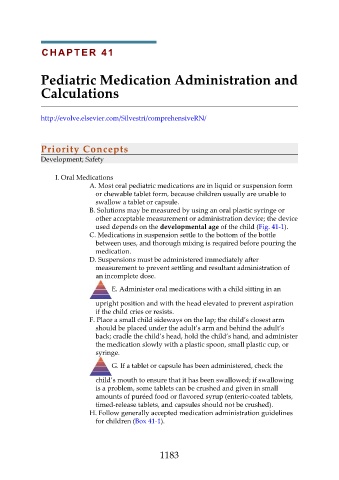Page 1183 - Saunders Comprehensive Review For NCLEX-RN
P. 1183
CHAPTER 41
Pediatric Medication Administration and
Calculations
http://evolve.elsevier.com/Silvestri/comprehensiveRN/
Priority Concepts
Development; Safety
I. Oral Medications
A. Most oral pediatric medications are in liquid or suspension form
or chewable tablet form, because children usually are unable to
swallow a tablet or capsule.
B. Solutions may be measured by using an oral plastic syringe or
other acceptable measurement or administration device; the device
used depends on the developmental age of the child (Fig. 41-1).
C. Medications in suspension settle to the bottom of the bottle
between uses, and thorough mixing is required before pouring the
medication.
D. Suspensions must be administered immediately after
measurement to prevent settling and resultant administration of
an incomplete dose.
E. Administer oral medications with a child sitting in an
upright position and with the head elevated to prevent aspiration
if the child cries or resists.
F. Place a small child sideways on the lap; the child’s closest arm
should be placed under the adult’s arm and behind the adult’s
back; cradle the child’s head, hold the child’s hand, and administer
the medication slowly with a plastic spoon, small plastic cup, or
syringe.
G. If a tablet or capsule has been administered, check the
child’s mouth to ensure that it has been swallowed; if swallowing
is a problem, some tablets can be crushed and given in small
amounts of puréed food or flavored syrup (enteric-coated tablets,
timed-release tablets, and capsules should not be crushed).
H. Follow generally accepted medication administration guidelines
for children (Box 41-1).
1183

